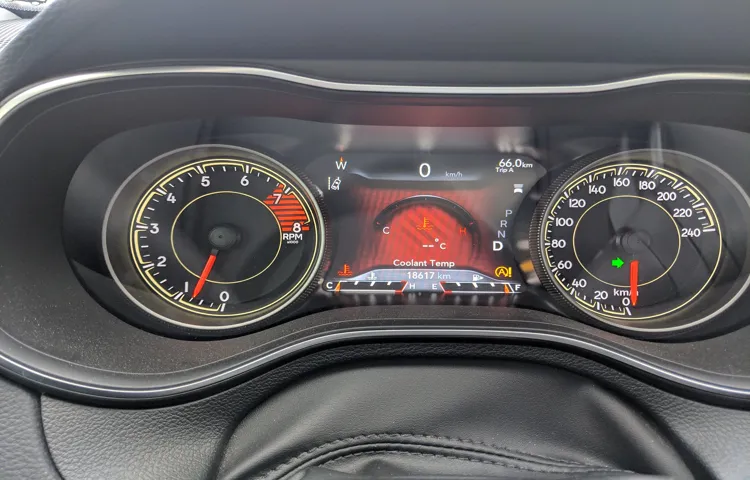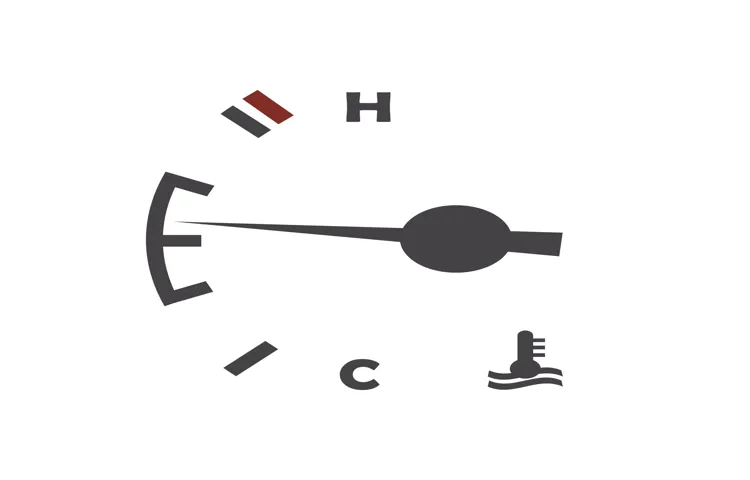As a vehicle owner, understanding engine temperature is crucial for maintaining the health of your car. One of the primary ways to determine engine temperature is by checking the coolant gauge. But, where should your coolant gauge be? Is it supposed to be at a specific level, or is it okay for it to fluctuate? These are common questions that arise in the minds of many car owners.
In this blog, we’ll explore how the coolant gauge works, what a normal engine temperature is, and what you should do if your coolant gauge is indicating a problem. By the time you finish reading this blog, you’ll have a better understanding of engine temperature and be better equipped to take care of your vehicle.
Table of Contents
What is a Coolant Gauge?
Have you ever wondered where your coolant gauge should be? Well, let’s first understand what a coolant gauge is. A coolant gauge is an instrument on your car’s dashboard that measures the temperature of the coolant in your engine. The ideal temperature range for your engine coolant is between 175°F to 225°F.
It is important to keep an eye on your coolant gauge to ensure that your engine is running smoothly and avoid overheating. If you notice that your coolant gauge is running hotter than usual, it is best to pull over and check your coolant levels. Remember, keeping a check on your coolant levels regularly can help avoid any potential damages to your engine, and ensure that your car runs efficiently.
Understanding The Components Of A Coolant System
A coolant system is a vital component of an engine that keeps it from overheating. It is made up of several parts that work together to transfer heat away from the engine and into the environment. The coolant gauge is one such part that plays a crucial role in monitoring the temperature of the engine.
It is usually located on the dashboard and measures the temperature of the engine coolant. If the gauge shows a reading that is higher than normal, it could indicate a problem with the cooling system. This could be due to a leak in the system, a malfunctioning coolant pump, or a clogged radiator.
Regular monitoring of the coolant gauge can help prevent costly engine repairs and ensure that the engine operates at optimal temperature. So, if you notice any abnormal temperature readings, it’s best to consult a professional mechanic to diagnose and fix the issue.

How Does Engine Temperature Affect the Coolant System?
Coolant Gauge A coolant gauge is a critical component of any car’s instrument cluster, as it indicates the engine’s temperature. It shows whether the engine is operating at the optimum temperature range or if it’s overheating, which is a significant problem that must be addressed. It’s important to pay attention to the coolant gauge because it’s the first sign of trouble in the coolant system.
An engine that is overheating can cause considerable damage to the car’s internal components, which can lead to costly repairs. Therefore, if the coolant gauge shows an abnormal reading, it’s essential to immediately stop driving and check the coolant level or take the car to a mechanic. Engine temperature directly affects the coolant system.
The coolant system is designed to regulate the engine’s temperature and keep it within the optimal range for efficient and safe operation. An engine that’s too hot can cause the coolant to boil and potentially damage the engine, resulting in expensive repairs. On the other hand, an engine that’s too cold may not reach optimal efficiency and performance levels, resulting in increased fuel consumption and reduced performance overall.
Therefore, it’s essential to maintain the engine temperature within the manufacturer’s specified temperature range, as indicated by the coolant gauge. In summary, a properly functioning coolant system is critical to the engine’s long-term health, and the coolant gauge is an essential instrument to monitor the system’s temperature.
Normal Operating Range for a Coolant Gauge
As a responsible car owner, you might be wondering where your coolant gauge should be under normal operating conditions. Typically, the optimal range for a coolant gauge is between the halfway point and three-quarters. The ideal range is usually marked in different colors and symbols on the gauge display panel.
If the needle is below the halfway point, it indicates that your engine is running too cold and might not be operating efficiently. On the other hand, if the needle is hovering around the maximum level, it means that your engine is overheating and in danger of major damage. Paying close attention to your coolant gauge can help you maintain a healthy engine and avoid costly repairs.
If you notice any unusual fluctuations, don’t hesitate to consult your car’s user manual or a qualified mechanic to ensure that everything is functioning properly.
Determining the Ideal Temperature Range for Your Vehicle
As a vehicle owner, it’s important to know the normal operating range for your coolant gauge to ensure your engine runs smoothly. The temperature range can vary depending on the make and model of your vehicle, but generally, the ideal operating temperature is between 195 and 220 degrees Fahrenheit. This range allows your engine to run efficiently and prevents it from overheating, which can cause damage and lead to expensive repairs.
It’s important to regularly monitor your vehicle’s coolant temperature to ensure it stays within this range, especially during long drives or in extreme weather conditions. Remember, keeping your engine running at the right temperature is crucial for the longevity and performance of your vehicle.
Factors That May Affect Your Coolant Gauge Reading
When it comes to monitoring the health of your vehicle, paying attention to the coolant gauge is essential. A normal operating range for a coolant gauge is typically between 195 to 220 degrees Fahrenheit. However, several factors can affect the reading of your coolant gauge, including the outside temperature, the driving conditions, and the age of your vehicle.
For example, if you are driving in extreme weather conditions, such as hot weather or through steep mountains, your coolant temperature may rise above the normal range. Moreover, an old or faulty thermostat may also cause irregular temperature readings. Therefore, it’s important to ensure that your vehicle undergoes regular maintenance checks to identify and fix any cooling system problems that may arise.
In conclusion, understanding how your coolant gauge works and what can impact its reading is key to maintaining your vehicle’s health and performance.
What to Do If Your Coolant Gauge is Reading Too High or Too Low
The normal operating range for a coolant gauge is typically between 195 to 220 degrees Fahrenheit. If your gauge is reading too high or too low, it can indicate a problem with your vehicle’s cooling system. If the gauge is reading too low, it could mean that there is not enough coolant in the system or that there is a leak.
On the other hand, if the gauge is reading too high, it may indicate that the engine is overheating due to an issue with the water pump, thermostat, or radiator. It’s important to address these issues promptly to avoid further damage to your vehicle’s engine. If you notice any fluctuations in the coolant gauge or you suspect a problem with your cooling system, it’s best to have a professional mechanic perform an inspection to diagnose and resolve the issue.
Remember, regular maintenance and inspections can help prevent these issues from occurring in the first place and keep your vehicle running smoothly.
Regular Maintenance for Your Coolant System
If you own a car, you know how important it is to maintain its various systems regularly. One of the most vital systems is the coolant system, which plays a crucial role in regulating the engine temperature and preventing it from overheating. But how do you know if your coolant system is functioning correctly? Your car’s coolant gauge can provide you with valuable information.
Ideally, your coolant gauge should be reading at or slightly below the halfway mark. If your gauge is reading higher, it may be an indication of a problem with your coolant system. In such cases, you should investigate the issue promptly to avoid any costly damage to your engine.
Regular maintenance of your coolant system is crucial to keep it running efficiently. Ensure that your coolant levels are adequate, check for leaks, and have your coolant system flushed at the recommended intervals by a professional. By keeping your coolant system in good working order, you can drive with confidence, knowing that your engine is protected from overheating.
Why Regular Maintenance is Crucial for Your Vehicle’s Cooling System
Regular maintenance for your coolant system is crucial to ensure the longevity and proper function of your vehicle. The coolant system is responsible for regulating the temperature of your engine, preventing overheating and potential damage. Neglecting regular maintenance can lead to the buildup of deposits and corrosion, which can clog the radiator and damage the water pump.
This can cause significant damage to your vehicle, leading to costly repairs. Additionally, low coolant levels can cause your engine to overheat, which can result in a blown head gasket or warped cylinder head. Regular maintenance, including flushing and refilling your coolant, inspecting and replacing hoses, and checking your radiator for leaks, can help prevent these issues and ensure optimal performance of your vehicle.
Don’t overlook the importance of regular maintenance for your coolant system – it can save you time, money, and stress in the long run.
Step-by-Step Guide for Checking and Maintaining Your Coolant System
Regular maintenance for your coolant system is crucial in preventing overheating and prolonging the life of your vehicle. To start, check the coolant level in the reservoir and top it off if it’s low, using a 50/50 mixture of coolant and water. Next, inspect the hoses for any cracks, leaks or bulges, and replace if necessary.
Check the radiator for any debris or damage, and clean or repair as needed. Additionally, consider replacing the thermostat and flushing the coolant every 2-3 years. Regularly maintaining your coolant system can save you from costly repairs and keep your vehicle running smoothly.
So, don’t wait until there’s an issue with your coolant system, make it a part of your routine car care.
Conclusion
In conclusion, the location of your coolant gauge is a crucial element in keeping your engine running smoothly. This gauge acts as the thermometer of your car, and just like in medicine, you want it to be in the “normal” range – not too high, not too low. So, make sure you keep an eye on it to prevent your engine from overheating or freezing in the cold.
As they say, happy gauge, happy engine, happy ride!”
FAQs
What temperature range is considered normal for a coolant gauge reading?
The normal operating temperature for a coolant gauge reading is typically between 195°F and 220°F.
What does it mean if my coolant gauge reads above the normal range?
If your coolant gauge reads above 220°F, it could indicate that your engine is overheating and requires immediate attention.
Should my coolant gauge reading fluctuate while driving?
Minor fluctuations in a coolant gauge reading are normal, but if the gauge constantly goes up and down, it could indicate a problem with the cooling system.
Can a faulty coolant sensor affect my gauge reading?
Yes, a faulty coolant sensor can cause inaccurate readings on the coolant gauge.
Is it safe to drive with a low coolant gauge reading?
No, driving with low coolant levels can lead to overheating and engine damage. It is important to check and maintain proper coolant levels.
How often should I check my coolant gauge reading?
It is recommended to check your coolant gauge reading every time you start your vehicle and periodically throughout your drive.
What should I do if my coolant gauge reading is consistently high?
If your coolant gauge consistently reads above the normal range, it is best to have your vehicle inspected by a qualified mechanic to diagnose the issue and prevent further damage to your engine.



